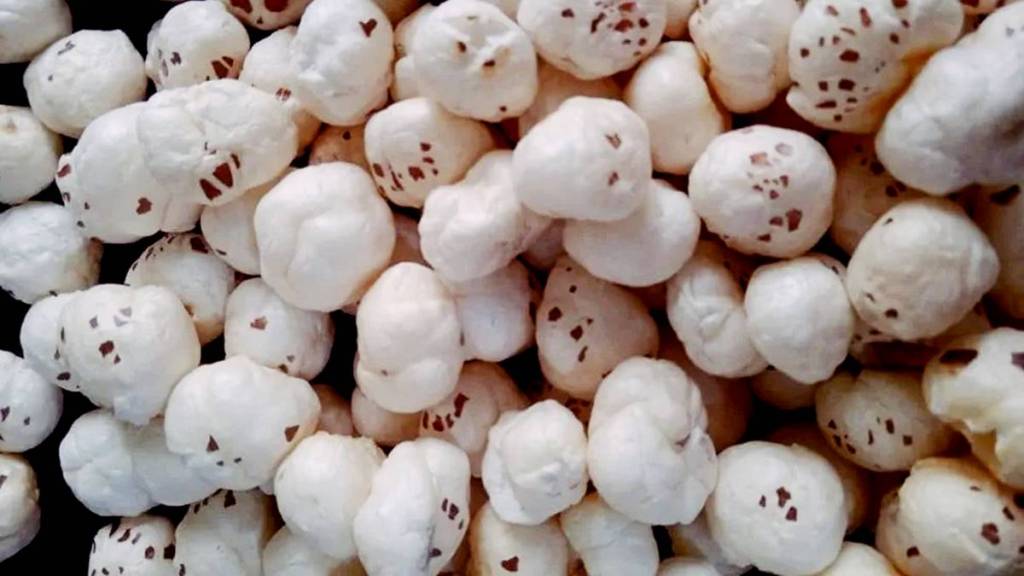Context
-
The government has awarded geographical indication (GI) tag to ‘Mithila Makhana’, in a bid to help farmers get the maximum price for their produce.
About Mithila Makhana
- Mithila Makhana is also simply known as ‘makhan’. Its botanical name is ‘Euryale Ferox Salisb’ and it is a special variety of aquatic fox nut.
- It is believed that the food is famously consumed during Kojagara Puja by Maithil Brahmins, who celebrate it for newly-married couples.

- Bihar harvests 80% of India’s total Makhana or Fox Nut supply.
- Its Botanical name is Euryale Ferox Salisb. This special variety of Aquatic Fox Nut is cultivated in the Mithila region of Bihar and adjoining areas of Nepal.
- Makhana is generally hailed as a healthy Indian snack. According to the Indian Journal of Traditional Knowledge, these seeds are edible after they are processed.
- They grow on a leaf in a pond, before they are collected, washed and sun-dried for hours. After that, they are roasted in a pan at a high flame. Following this, their outer shells are broken and the white puff comes out.
- Fox Nuts are rich in protein and fiber and have various micro-nutrients such as magnesium, calcium, phosphorous and iron.
- It is said to be low in cholesterol, fat and sodium, and also an ideal weight-loss snack as it is low in calories.
- They also help one to overcome insomnia and arthritis, and improve cognitive functions.
- Interestingly, Mithila Makhana — which, as indicated by its name, is cultivated in the Mithila region of Bihar and some parts of Nepal is the fifth product from Bihar which has received the GI tag. Prior to this, Bhagalpur’s Jardalu Mango, Katarni Dhaan (rice), Nawada’s Maghai Paan and Muzaffarpur’s Shahi Litchi have been recognised.
Back to Basics
WHAT IS GI TAG?
- Geographical Indication (GI) Tags act as a special identification ascribed to any region, town, or state.
- These tags are assigned to certain products like agriculture or handicraft or food that symbolise the uniqueness of that particular region or place.
- India, as a member of the World Trade Organization (WTO), enacted the Geographical Indications of Goods (Registration and Protection) Act, 1999.
- Later it came into force with effect from 15 September 2003. GI has been defined under Article 22 (1) of the WTO Agreement on Trade-Related Aspects of Intellectual Property Rights (TRIPS) Agreement as: “Indications which identify a good as originating in the territory of a member, or a region or a locality in that territory, where a given quality, reputation or characteristic of the good is essentially attributable to its geographic origin.”
- Once a product is given a GI Tag, it cannot be sold under the same name.
- This tag is valid for up to 10 years and can be renewed thereafter again. GI Tags thus provide assurance of innovativeness, quality and distinctiveness of the product.
- GI tags mean that that product, name or sign thus assigned is unique, bears distinctive qualities, are made with traditional methods representing the reputation of the region.
- One can also view this tag as a means of protection from any sort of copyright violation
- The Darjeeling Tea was the first product in India that was given a GI tag around 2004-2005. Basmati Rice, Kashmir Saffron, Kangra Tea, Thanjavur Paintings are few of the famous goods that are awarded with this tag.
Visit Abhiyan PEDIA (One of the Most Followed / Recommended) for UPSC Revisions: Click Here
IAS Abhiyan is now on Telegram: Click on the Below link to Join our Channels to stay Updated
IAS Abhiyan Official: Click Here to Join
For UPSC Mains Value Edition (Facts, Quotes, Best Practices, Case Studies): Click Here to Join
